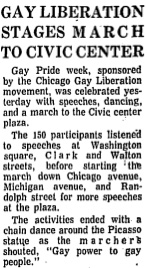The 46th annual Chicago Pride Parade will be held this Sunday at noon, and this year's edition could be special for a few reasons.
The Supreme Court ruled this week—just in time for Pride—that same-sex marriage is now legal in all 50 states. But the raucous Pride celebration that is sure to follow could also be the last that Boystown will see. According to DNAinfo, the parade is on the verge of outgrowing the neighborhood and could move downtown starting in 2016.
The primary reason for the change? Crowd control. While the first gay pride parade had only a few hundred attendees, last year's march drew one million people to the route. Police also arrested 45 people throughout the day. The change will be decided early next year, but it wouldn't come as a surprise to Tracy Baim, the publisher of Windy City Media Group and author of Out and Proud in Chicago.
"Our community can’t expect that we have exceptionalism," Baim says. "Every other parade is judged by its merits and its problems. Look at the St. Patrick's Day parade. The city has to treat us like it treats everyone else. I think people want to keep it there as long as it makes sense, but if there are some incidents that happen this Sunday…we'll see what happens this year."
And while it may strike some as odd to move the gay pride parade out of Boystown, the event didn't actually start there. When the "Gay Liberation Movement" organized its first-ever march in the city in 1970 on the anniversary of the Stonewall Riots, Boystown as you know it didn't exist.
Before diving in, it's important to note that the gay community in Chicago took root long before Stonewall. Way back in 1924, Chicago’s Henry Gerber formed "the nation's first chartered LGBT rights organization." (Just last week, the U.S. Department of Interior declared the Henry Gerber House in Old Town a National Historic Landmark, the second-ever LGBT-related property to earn such a distinction.) But while Chicago would continue to see gay activists rise to prominence in the coming decades, the first gay pride parade wouldn't be until June 27, 1970.

That day, about 150 people marched from Clark and Walton Streets to the Daley Center (then known as the Civic Center). The Tribune ran a 75-word blurb about the event on the third page of its June 28 edition, noting that it ended with festgoers circling the Picasso statue in the plaza and shouting, "Gay power to gay people."
After that, the parade tended to follow the gay community. "Fifty years ago, River North was where the heart of the community was," Baim says. "Over the decades it began to move north. It was Broadway and Diversey for a while, then up to Halsted Street."
By 1973, the parade had moved its starting point to Belmont Harbor. The "gay liberationists" leading the charge numbered 300, according to the Tribune. That number would swell to "thousands" by 1980. At that point, the parade had moved closer to its currently location, starting at Addison and Halsted, in an area then referred to as "New Town."
New Town first entered the Chicago lexicon around 1969, when high-end fashion retailer Paul B. Magit opened a boutique at 2900 North Broadway Street. Current residents despised the influx of overpriced stores and "young singles looking for action." (That's a quote from an oddly prescient Tribune column in 1971, “New Town Charm Loses to Glitter.”)
The first gay bar on Halsted Street, Little Jim's, opened in 1975, and others soon followed, among them the Loading Dock (now the Kit Kat Club), Christopher Street (now Hydrate), and Sidetrack (opened in 1982 and still in business). As Chicago noted in 1983, in an article about gay life here:
Today, Chicago's gay population is about half a million, though obviously no one has taken a census. It is most visible in the New Town area on the North Side, with its string of gay bars and bathhouses that are commonly the centerpiece of media coverage.
Jane Byrne was the first mayor to officially recognize the event, issuing a Gay Pride Parade Day proclamation in 1981. In 1997, Mayor Daley declared the six-block stretch of Halsted from Grace to Belmont the first official gay neighborhood in America. More than a few Chicagoans protested the idea. Tribune columnist Mary Schmich wrote in August of that year:
What's that noise I hear? It's the sound of us heterosexuals squirming.
We're the heterosexuals who believe that homosexuals deserve equal respect and equal rights. We eat in gay-run restaurants, we shop in gay-run stores. Some of our best friends, as we say, are gay.
But now that the city plans to turn six blocks of North Halsted Street into an officially designated gay neighborhood, we find ourselves uncomfortable with our initial thought: This idea stinks.
The title of that column: "Gaytown Enters Gray Area Of Community Naming."
(Before you get too excited, know that Gaytown wasn't really ever proposed as a possible name for the neighborhood. "It was a pretty temporary name," Baim recalls. "The point was [to sound] like Greektown.")
Boystown, which Schmich even refers to in her article, was adopted into mainstream use after Daley's announcement, but it had been thrown around the gay community starting in the late ’80s/early ’90s, according to Baim. "New Town sort of fell off," she says. And Boystown picked up because: "The area was almost all male and white. There were others, but those were the most dominant and visible people in this community that was gravitating north."
Today, Boystown continues to thrive as a particularly gay-friendly part of town—it was voted the "most incomparable gay neighborhood" in the nation by Out Traveler in 2014. But while it's now home to dozens of gay bars and gay-owned restaurants, depending on what happens on Sunday, it may not be the parade's home much longer.




Comments are closed.